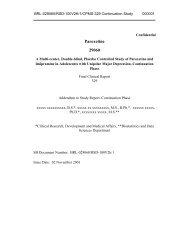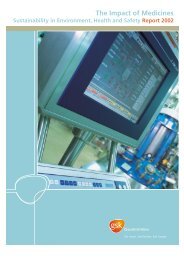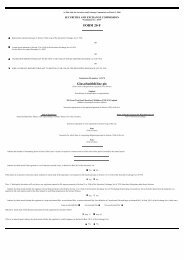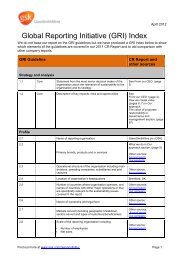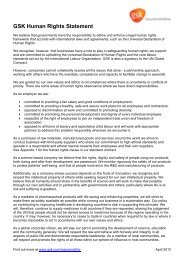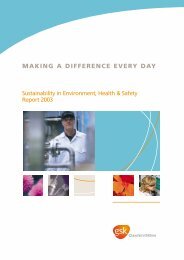GSK Annual Report 2002
GSK Annual Report 2002
GSK Annual Report 2002
Create successful ePaper yourself
Turn your PDF publications into a flip-book with our unique Google optimized e-Paper software.
As part of GlaxoSmithKline’s major response to the challenges of<br />
diseases affecting the developing world, the Microbial,<br />
Musculoskeletal & Proliferative Diseases CEDD has responsibility for<br />
a drug discovery unit, based at Tres Cantos, that is dedicated to<br />
finding new medicines for these diseases. Research projects at<br />
Tres Cantos focus on malaria and TB and, together with work<br />
elsewhere in the Group on HIV/AIDS and vaccines, address the<br />
prevention and treatment of all three of the World Health<br />
Organization’s (WHO) top priority diseases. The Group also works<br />
with numerous external partners worldwide in the search for new<br />
treatment for Diseases of the Developing World (DDW).<br />
Preclinical development<br />
Preclinical Development (PCD) participates in a wide range of<br />
activities within the drug development process from optimising the<br />
selection of compounds for potential development through launch<br />
to the marketplace and enhancement of existing products by<br />
devising more convenient formulations. Early in the development<br />
process, the metabolic fate and safety of compounds are evaluated<br />
in laboratory animals prior to testing in humans. The testing<br />
required in both animals and humans is mandated and is highly<br />
regulated by governmental agencies.<br />
PCD researchers investigate dosage form (e.g. tablet or inhaled)<br />
and develop formulations to enhance the drug’s effectiveness. PCD<br />
is also responsible for the development of drug formulations used<br />
in clinical trials. Processes and supporting analytical methods for<br />
drug synthesis and product formulation and delivery are scaled up<br />
to meet increasing supply requirements, ultimately leading to the<br />
technical transfer of the processes and methods to manufacturing.<br />
The New Product Supply Process, a partnership between R&D and<br />
Global Manufacturing and Supply, ensures that a robust product is<br />
developed for large scale commercial manufacturing and launch.<br />
PCD is pursuing novel technologies to enhance R&D productivity<br />
by lowering the rate of project failure, reducing cycle time and<br />
enhancing product value. Predictive toxicology, an integrated multidisciplinary<br />
collaboration between PCD, DR and Genetics Research,<br />
has been established to improve the quality of candidate selections<br />
and reduce late-stage attrition due to toxicity.<br />
Other key technology areas that provide ways to improve R&D’s<br />
productivity include drug delivery systems, predictive technologies,<br />
particle engineering and process innovation. The use of particle<br />
engineering and process innovations enhances the ability to<br />
manufacture efficiently consistently high-quality products.<br />
New product development<br />
To provide focus for the development and commercialisation<br />
process, which must proceed in unison, all the major functional<br />
components clinical, medical, biomedical data, regulatory, safety<br />
and commercial strategy, have been integrated into this single<br />
management organisation, New Product Development (NPD).<br />
There are six cross-functional Therapeutic Area Strategy Teams,<br />
each covering one of the following groups of diseases:<br />
• Cardiovascular, Urogenital and Metabolic Diseases<br />
• Infectious Diseases including DDW<br />
• Neurology & Gastro-intestinal Diseases<br />
• Oncology, Musculoskeletal Diseases and Inflammation<br />
• Psychiatry<br />
• Respiratory.<br />
Description of business GlaxoSmithKline 21<br />
These matrix teams are responsible for maximising the worldwide<br />
development opportunities for each product within their remit.<br />
They ensure that at an early stage regional marketing needs are<br />
fully integrated into any development plans so that all information<br />
needed to support the registration, safety programmes, pricing and<br />
formulary negotiations is available. Careful prioritisation across all<br />
phases of development ensures that a high potential and<br />
integrated portfolio is achieved.<br />
The teams collaborate at an early stage with the CEDDs to define<br />
target product profiles for new molecules and with integrated<br />
technical development and manufacturing functions to ensure<br />
rapid, effective launch and delivery of the product. Innovative<br />
clinical programmes for lead molecules from the CEDDs are<br />
developed using cross-functional project teams.<br />
During <strong>2002</strong> a new group, Translational Medicine & Technology,<br />
was established within NPD to optimise the use of a variety of<br />
technologies to reduce risk and cost across development.<br />
Cross-functional input extends to focused lifecycle management for<br />
products to deliver new indications and new presentations after<br />
the initial regulatory approval and commercial launch. Examples of<br />
lifecycle management include the extended release formulation,<br />
Augmentin XR, and development programmes designed to deliver<br />
new indications such as the use of Seretide/Advair for chronic<br />
obstructive pulmonary disease (COPD).<br />
A new initiative, Gold Pass, was implemented in <strong>2002</strong>. This<br />
designation, agreed between R&D, regional markets and<br />
manufacturing, is a key component of the portfolio and resource<br />
prioritisation and management process, to ensure that the<br />
resources placed behind key emerging assets yield the optimum<br />
commercial benefit as well as the maximum medical benefit to<br />
patients. Gold Pass assets are of high value and strategic<br />
importance to GlaxoSmithKline and require specific organisational<br />
visibility and urgency to meet patients’ needs. Consequently, only a<br />
small number of assets receive Gold Pass status at any one time,<br />
enabling the full focus of the organisation to be aligned.<br />
In-licensing and research collaborations<br />
GlaxoSmithKline has continued to identify compounds that would<br />
enhance the portfolio and to create innovative collaborations to<br />
ensure that the Group is regarded as the partner of choice for both<br />
large and small companies. Compounds that were the subject of<br />
in-licensing or co-promotion deals during <strong>2002</strong> and in January<br />
2003 were:<br />
• alvimopan (ADL 8-2698), an oral mu-opoid antagonist, in<br />
Phase III for post-operative ileus, to be co-developed and<br />
co-promoted with Adolor<br />
• BVT 933 and other 5HT2C receptor agonist compounds, the<br />
most advanced of which is in Phase II for obesity, in-licensed<br />
from Biovitrum. Biovitrum retains exclusive<br />
commercialisation rights for five Nordic countries, while<br />
GlaxoSmithKline has exclusive rights elsewhere<br />
• 842470 (AWD 12-281) and backup compounds, the most<br />
advanced of which is in Phase II (intra-nasal delivery) for<br />
allergic rhinitis and Phase I (inhaled) for asthma and COPD,<br />
in-licensed from elbion AG<br />
• a preclinical development programme of PPAR-gamma<br />
modulators, the most advanced of which, BAY 54-9801 is in<br />
development for osteoporosis, in-licensed from Bayer AG.<br />
Bayer retains the right to claim certain compounds for its<br />
own use in the fields of cardiovascular disease and oncology








